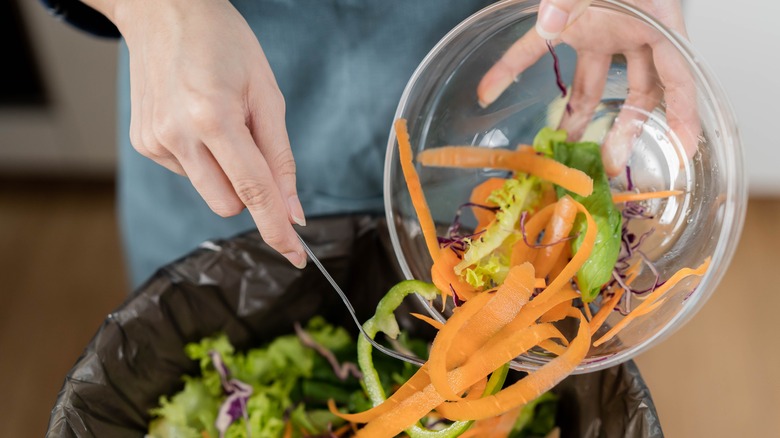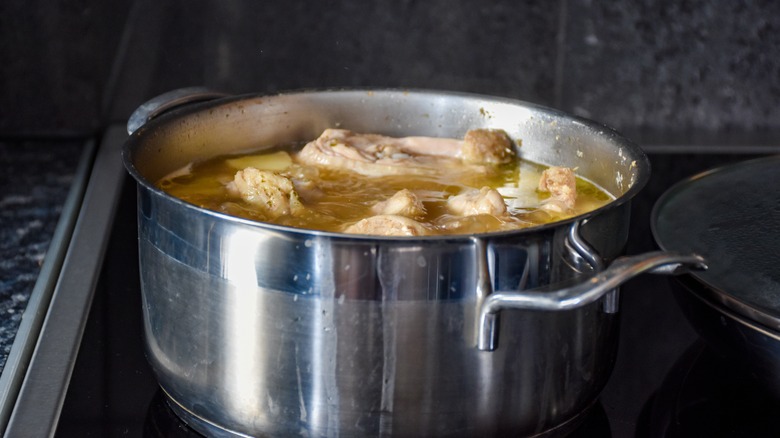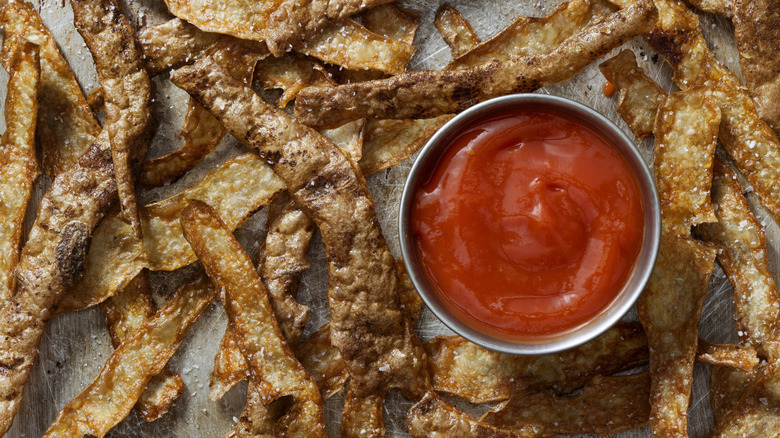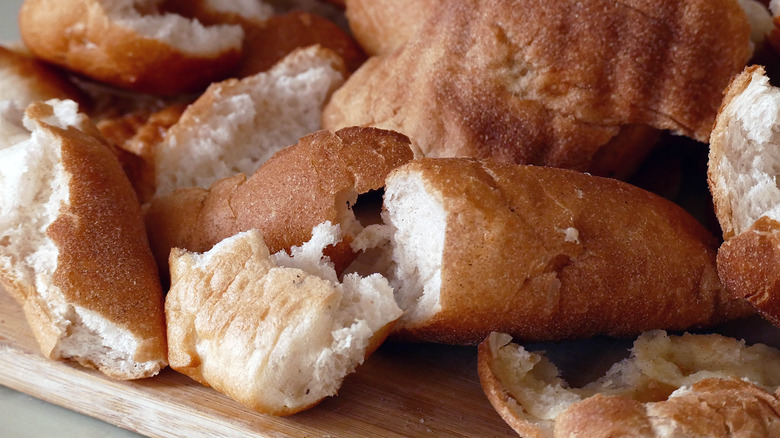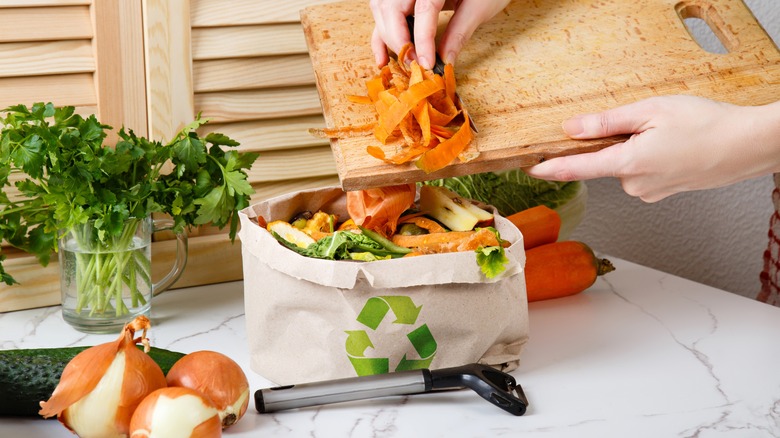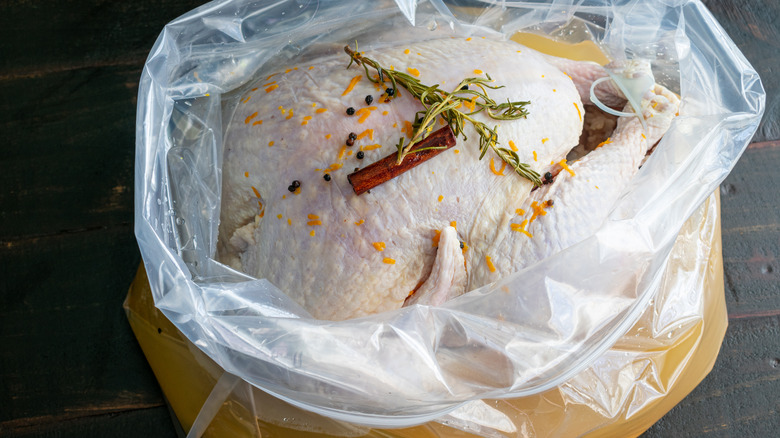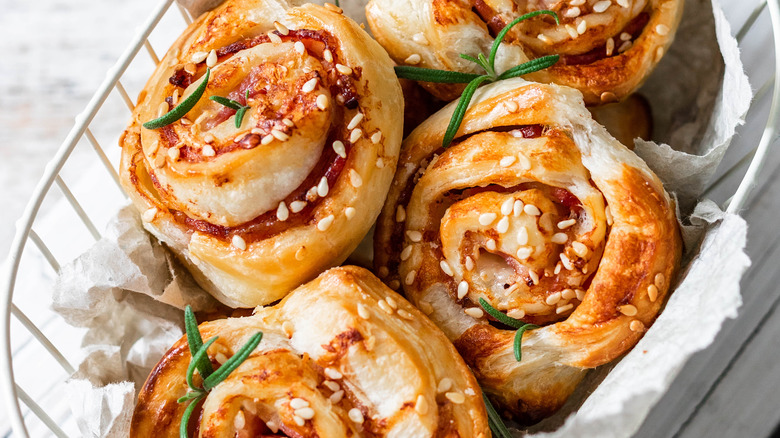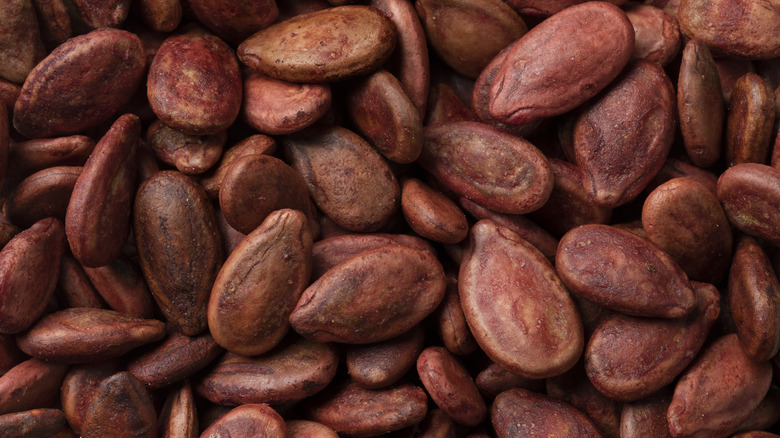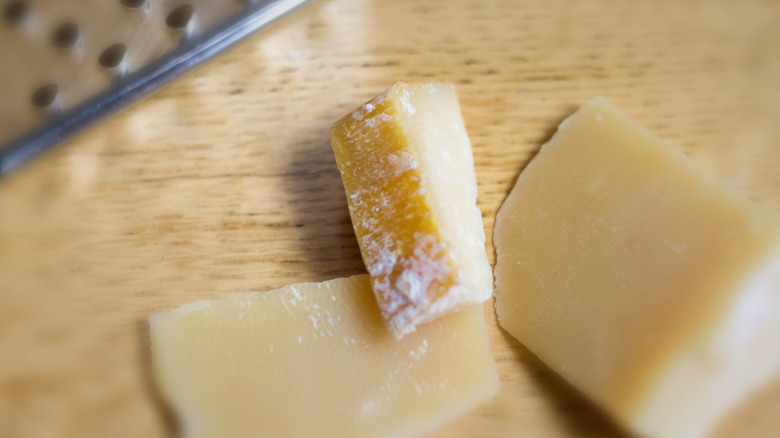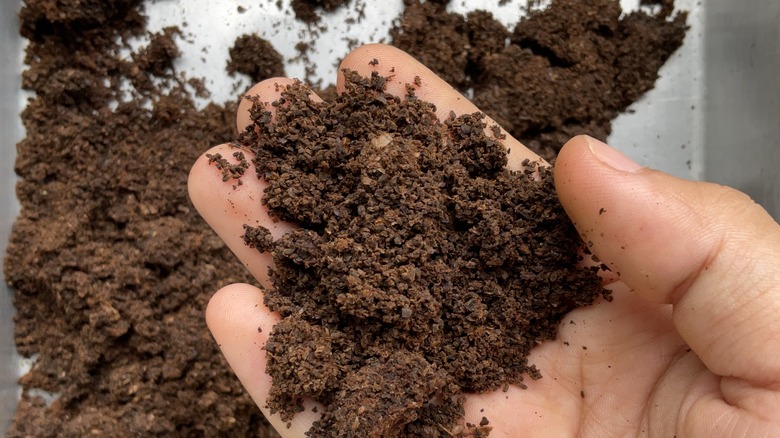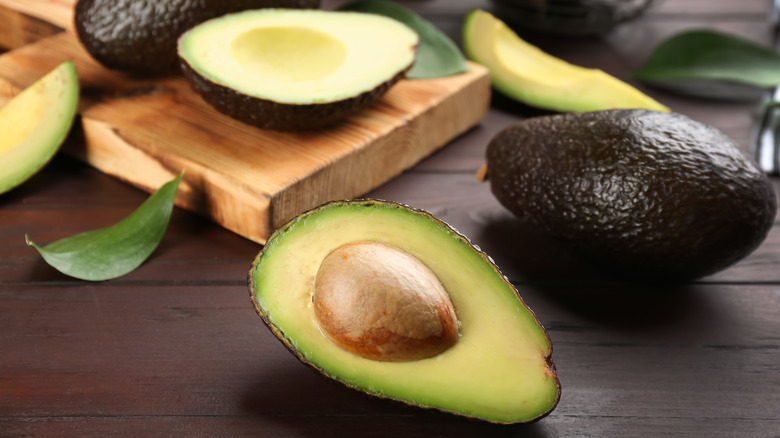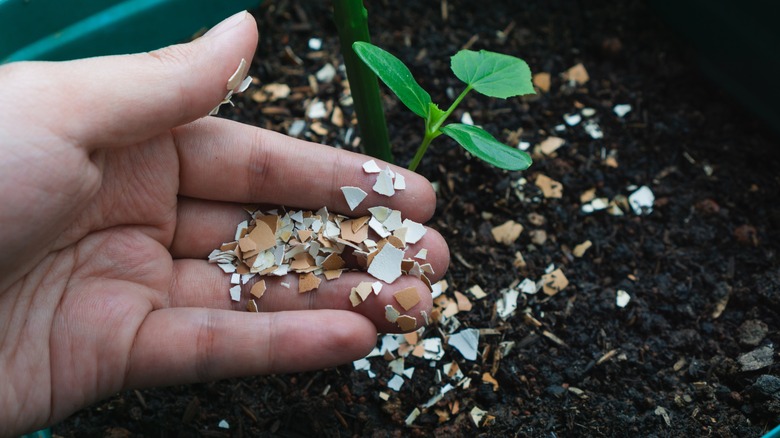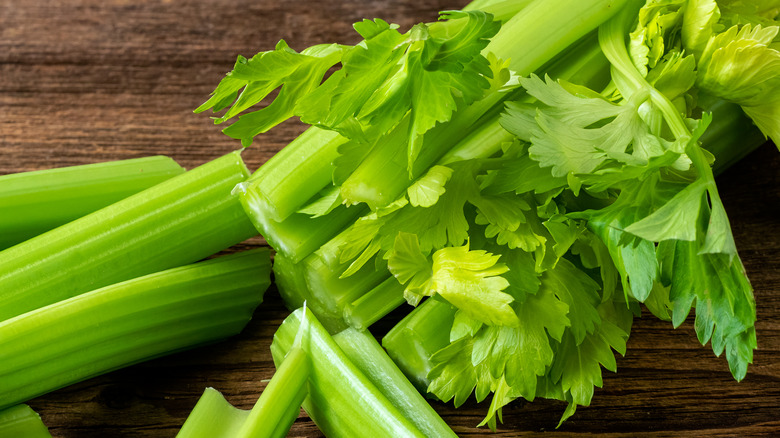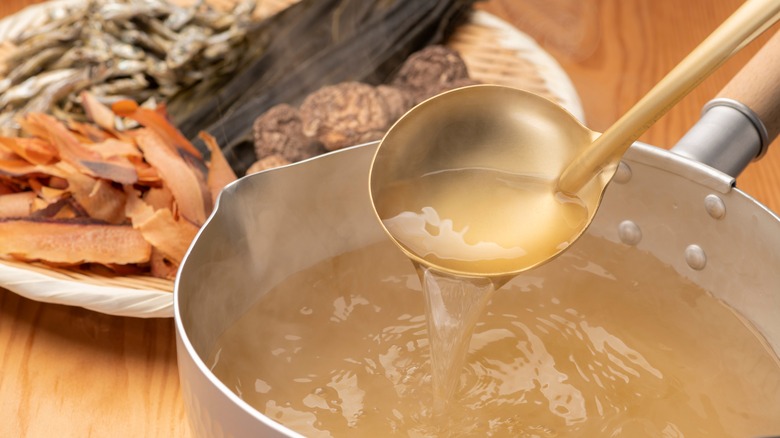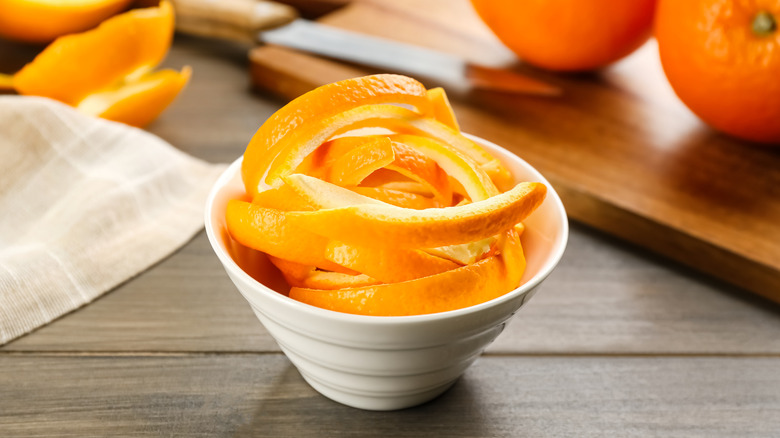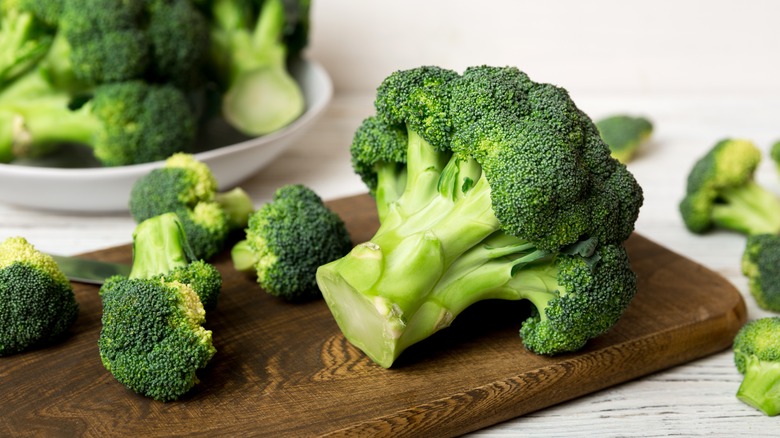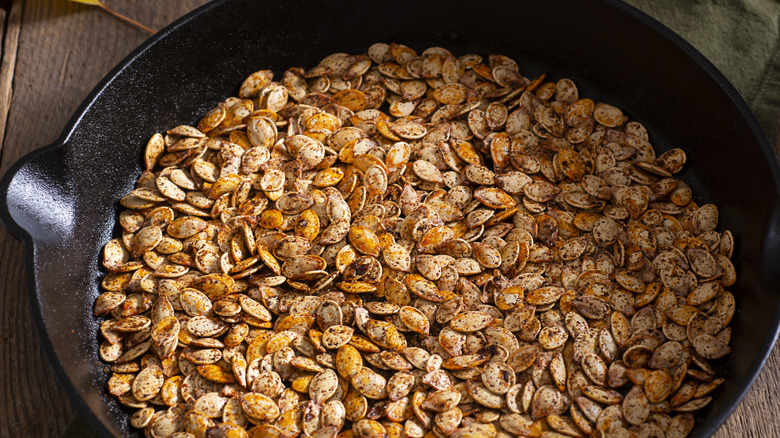16 Food Scraps You Shouldn't Actually Throw Out
There are plenty of valid reasons for us to consider how much food we waste. Not only are we facing ever-increasing food costs that eat into our grocery budget, but waste continues to affect our ailing environment when it's packed into landfills around the world.
The figures speak for themselves. According to the food insecurity charity Feeding America, the United States wastes 149 billion meals worth of edible food every year, which is nearly 40% of all food produced in the country. While the task of reducing this number might seem insurmountable to us as individuals, there's plenty we can do in our own kitchens. With some new habits we can save some money, discover new recipes, improve our health, help our gardens flourish, and do our bit to preserve our precious planet. Below are some scraps that you should think twice about before consigning to the trash, as well as some of the ways in which you can put them to good use.
Chicken bones
Most of us resign our chicken bones to the trash once they've been picked clean, but keeping hold of them can be the key to elevating your cooking and boosting your health. Bone broth isn't exactly a new invention, and you might be surprised by how cheap and easy it is to make at home instead of paying a premium for the stuff at your local health food store or grocery.
Simply heat the bones in plenty of water with the herbs and seasonings of your choice and a little apple cider vinegar to help break down the collagen. When the pot reaches a boil, switch to a simmer and reduce the liquid to around a third of its original volume. This process can take around 12 hours but doesn't require much intervention, and it will leave you with a nutritious stock that you can use for soups, sauces, or even a tasty, savory sipping snack.
Potato skins
While you can save your potato skins and peelings for the compost heap, throwing them away means you're missing out on a significant proportion of the nutrients and vitamins that the vegetable has to offer. There seems to be a bit of a misconception that potato skins are unhealthy, but it really depends on how you prepare them.
If you're left with whole skins after eating a baked potato, you can turn the leftovers into makeshift hash browns by slicing them up and frying them in a little oil or fat. If you find yourself left with peelings instead of full skins, it's super simple to make homemade chips to save them from being wasted. Lightly toss the peelings in some olive or vegetable oil and season them how you see fit — a pinch of sea salt will do the trick, but feel free to get creative. Pop them in the oven at 425 degrees Fahrenheit for around 15 to 20 minutes until they turn golden brown and crispy.
Stale bread
While there are ways to revive stale bread, it's not always worth the time and effort. As long as it isn't moldy, though, you can still find plenty of uses for bread that's past its prime.
Stale bread has numerous uses, like adding texture to salads in the form of croutons or being used for a simple yet tasty bread pudding. You can also break the bread down into smaller crumbs to create crispy coatings for chicken wings or to act as a binding agent in meatballs or burgers. If you want to get really creative, you can even have a go at using stale bread to make passatelli, a type of pasta that just needs some eggs and grated parmesan for the dough. The best part is that, instead of boiling the pasta in water, Italians traditionally use chicken broth, which you can make yourself with those chicken bones you saved from earlier.
Vegetable scraps
We tend to have a lot of scraps on hand after prepping vegetables, whether that's the peeled skins, thick stems, or discarded leaves. Just because these aren't suitable for the dish we're making, doesn't mean those nutrient-dense remnants aren't worth saving.
As with chicken bones, vegetable scraps can be saved for making a vegetarian-friendly broth or adding to a meaty stock for extra flavoring. Alternatively, they're extremely effective for making nutritious, hearty soups and stews. Just be aware that some scraps, like broccoli and cauliflower stems, can turn a broth bitter when they've been boiled for a long time. If you've got wilted greens, like kale or spinach, these can be saved too — simply blend up the leftover leaves and use them to supplement your favorite pesto recipe. If you can't find a culinary use for your veggie leftovers, it might be time to consider composting them in order to recycle those nutrients in your garden.
Brine
When you've polished off a jar of pickles or olives, you may have found yourself wondering whether it's really necessary to pour away that delicious, tangy brine. The answer is actually no, at least not if you follow a few basic guidelines.
As a rule of thumb, you shouldn't reuse brine from canned foods, and you don't want to reuse brine that's been used to preserve raw meat because doing so could result in food borne illnesses. However, if you want to reuse pickle brine to make more pickles, feel free! You may want to refresh it with some extra vinegar, sugar, and some more seasoning, but otherwise it's perfectly suitable. Provided you've got enough pickle juice, you can even use it to tenderize lean meats like turkey before roasting. There are also plenty of uses for brine in cocktails, with both olive and pickle brine adding a deliciously savory element to drinks like martinis and Bloody Marys.
Puff pastry
Puff pastry is something that's usually not worth creating from scratch, but whether you've gone through the effort of making it yourself or you've stuck to the store-bought variety, you should never throw away the unused pastry scraps.
While it is technically possible to combine your cuttings to create a larger piece of usable pastry, the way puff pastry is made and folded to become light and airy means that is easier said than done. Instead, just keep your trimmings as intact as possible. Then you can turn the leftover pieces into sweet or savory canapés by adding toppings of your choice before or after brushing them with butter and baking them. With larger cuttings, you can roll them up into filled scrolls. Alternatively, you can get creative and turn the scraps into decorative pieces to adorn the dish you were making in the first place by cutting them into shapes and affixing them to pie tops with brushed egg white before baking.
Watermelon seeds
Watermelon seeds are often overlooked as a tasty snack because most people don't realize they're actually edible. In fact, they're a great source of zinc and contribute to our daily iron and magnesium requirements.
The easiest way to save your seeds is to rinse them off and then make sure they're dried thoroughly, which you can do with a paper towel or by leaving them out in the sun. Once dried, lightly toss them in oil with a little salt and either roast them in the oven or toast them in a frying pan by adding salted water and cooking them until the water evaporates. If you're willing to put in the effort of de-shelling the seeds, you can even make your own tahini-esque watermelon seed butter. It may be easier to sprout the seeds first to help with getting the shells off, but then all you need to do is blend them in a food processor with a little oil, and voilà, you've got yourself a creamy, tasty spread.
Cheese rinds
If you find yourself with a cheese that has a rind on it — the hard outer layer that forms during the aging process — it may surprise you to know that it's completely edible. That being said, eating the rind as it is, is not particularly appealing thanks to its tough and grainy texture. But that doesn't mean it can't be used to delicious effect in cooking.
Whether you're making a rich soup, creamy risotto, or decadent pasta sauce, you should follow the Italian tradition of saving your rinds and adding them to your dishes as they cook. The cheese rind will melt as your sauce simmers, thickening the base and introducing all sorts of cheesy, umami characteristics into the recipe. Bear in mind that different cheeses will produce different flavors. For example, a Gouda rind will add a milder flavor than that of a stronger, more pungent cheese, like parmesan.
Coffee grounds
Most of us know by now that it's not a good idea to dispose of spent coffee grounds down the sink, and that you should also think twice before putting them in the garbage disposal. But before you throw them in the trash bin, you should also know that they can still be of use.
If you compost, nutrient-rich coffee grounds are a beneficial addition to your natural fertilizer. They're great at absorbing odors too — a small bowl of coffee grounds in your fridge, gym bag, or car can help neutralize less-than-pleasant smells that might have built up over time. It's also possible to use the grounds to make your own exfoliating skin scrub. Simply mix the grounds in a bowl with a little coconut oil. Apply the scrub to your body and face, avoiding your eyes, then rinse it off. The grounds will help remove dead cells while the antioxidants in the caffeine may help to protect your skin from sun damage.
Avocado pits
Given the hefty size of an avocado pit, most of us have probably wondered if there isn't a use for it once we've devoured the rest of the creamy fruit. It's true that you can attempt to grow your own avocado tree, but the pit can take weeks to sprout and over a decade to start producing edible offspring.
For more immediate benefits, it's worth saving your avocado seeds and using them to make a rich, energizing cup of tea. Just boil the pit in a few cups of boiling water for a few minutes until it's soft enough to chop into small pieces. Then, pop the diced pieces back into the boiling water for another 10 minutes to brew the tea. (Be sure to strain them out before drinking.) Not only does the pit contain plenty of macronutrients, it's also an excellent source of antioxidants, and it's believed to have both antifungal and antibacterial properties that might help in staving off illness.
Eggshells
The hardened texture of eggshells can make it easy to forget that they're an organic material, specifically, calcium carbonate. While this doesn't necessarily mean we want to eat them, it does mean that they can still be useful once we have the whites and yolks out of them.
There are numerous ways to recycle spent eggshells, with the most simple one being to divert them to your garden instead of the trash. Finely ground egg shells can help fertilize plants with their rich calcium and reduce acidity in soil, whereas larger pieces of shell are effective at keeping small pests away from your greenery. You can also take advantage of the coarseness of ground-up eggshells to make your own toothpaste or skin exfoliant, or to sharpen the blades of your food processor. If you try any of these, it's important to minimize the risk of salmonella by sterilizing the shells in your oven at 200 degrees Fahrenheit for around 15 minutes to kill any unwanted microorganisms.
Celery leaves
For some reason, there seems to be a bit of a misconception that celery leaves are toxic and should be avoided at all costs. Regardless of the roots of this rumor, the truth is that they're both edible and nutritious.
That being said, the outer and inner leaves do differ, so you'll want to bear this in mind before you cook with them. The outer leaves are usually tougher with a very intense celery-like flavor, so they're best when blended into a soup, sauce, or smoothie. You can also dice them up finely and use them as a fresh herb like you would with parsley or cilantro. The inner leaves, on the other hand, are still flavorful but softer in texture and less overwhelming. These are the leaves you can save for bulking up salads and using their sharp taste for cutting through fattier ingredients like eggs and oily dressings.
Seafood scraps
Much like meat scraps, repurposing seafood leftovers will help you avoid waste and enhance your cooking. Fish bones and heads are worth saving, as are the shells of shrimp and other crustaceans you've just had the pleasure of eating.
With fresh seafood scraps at the ready, you'll be able to whip up a delicious fish stock, or fumét, as it's known in French cuisine. The best part is that, thanks to the intense flavors, fish stock only takes a fraction of the time to create as other bone broths do. All you need is water, herbs, seasonings, some white wine, and a few classic vegetables, and you can have a batch ready to go in less than an hour. You can then use it in all manner of fishy soups, stews, and sauces. Seafood stock is also the perfect ingredient for rich and creamy dishes like chowder or risotto, and you can use it to poach more delicate fish and increase their tastiness tenfold.
Citrus peels
Throwing away citrus peels is a huge waste of the fruit's potential, as those skins don't just contain nutrients, but an abundance of aromatic oils and flavorful compounds. For starters, saved peels can be grated to add a citrusy zest to a huge range of dishes, from sweet cakes to savory salads.
They're also ideal for any home bartender. Not only can they be used for simple yet fragrant garnishes, they're an excellent ingredient for infusing spirits like vodka or gin with an extra fruity element. If you really want to up your mixology game, try your hand at making an oleo-saccharum. Latin for "oil-sugar," this unbelievably tasty syrup uses sugar to extract the natural citrus oils from the peels. It's a simple two-ingredient recipe that, when mastered, will absolutely elevate cocktails and fruit punches alike. If you end up with more citrus peels than you need, you can freeze and subsequently defrost them whenever you need.
Broccoli stems
While most of us probably know that the thick stems of broccoli are edible, it's usually a bit too much hassle to try and cook them. Instead, we tend to just slice off the florets for cooking and discard the rest. It's understandable that you don't want to cook the stems with the rest of the broccoli, as they take much longer to soften. Yet, throwing them away really is a waste of good vegetables, as you're effectively halving the amount of nutrients available to you.
You've got a few different options here, beyond the compost heap, of course. First, you can save the stems and add them to a veggie stock with your other scraps. You can boil the stems until they're soft enough to go into a blender where they will effortlessly bolster a healthy green smoothie. Lastly, you can always slice or grate the stems into smaller pieces that won't take as long to cook, then throw them into your next stir fry.
Pumpkin seeds
Whether you've just finished carving a Halloween pumpkin or whipping up a delicious pumpkin pie from scratch, you're missing a trick if you resign those seeds to the trash. However, before you can use them effectively, there's a little bit of prep to do.
First, you'll want to thoroughly clean the seeds to remove the gooey pumpkin pulp before making sure they're properly dried. You can scarf down pumpkin seeds raw, but they're also a superb addition to salads, pastas, dips, and baked goods like cakes, breads, and muffins. Or, with a little salt and oil, they'll taste delicious after roasting in the oven for a few minutes. Once cooled, you'll have a delicious, nutritious snack, and you can experiment with all sorts of different seasonings before and after you cook them. Plus, you can always blitz them in a food processor to make a crumb for meat or fish, or use the finely ground seeds to make sauces like Mexican mole or a fresh green pesto.

